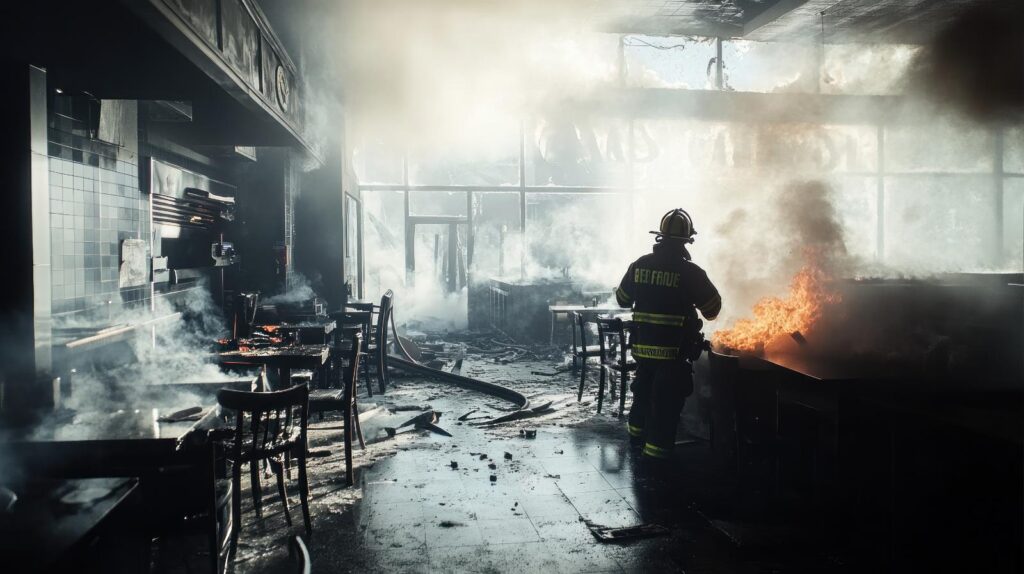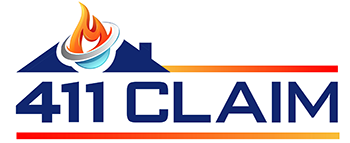
Contents
Did you know that fire damage cleanup isn’t just about removing charred debris? It involves a careful, systematic approach to guarantee safety and restore your property effectively. The first step is evaluating the damage, which sets the tone for everything that follows. By understanding the extent of the destruction, you can better protect yourself and your belongings as you move forward. Let’s explore the essential steps you need to take to address this serious situation.
Key Takeaways
- Assess structural stability and safety before entering the building to ensure safe cleanup.
- Wear appropriate protective gear, including masks and gloves, to safeguard against contaminants.
- Remove debris and ashes responsibly, sealing them in containers and following local disposal regulations.
- Clean and restore belongings, using proper techniques and professional help for delicate items.
- Implement fire prevention measures, including checking smoke detectors and educating family members on safety practices.
Assessing the Damage
When you begin evaluating the damage after a fire, it’s vital to prioritize safety. First, verify the structure’s stability before entering. Look for signs of weakened walls, ceilings, or floors. Use proper personal protective equipment (PPE), like gloves and masks, to shield yourself from harmful residues.
Next, conduct a thorough damage evaluation. Take detailed notes and photographs of all affected areas, including structural damage, smoke, and water damage. This documentation will be important for your insurance claim, so be meticulous.
As you assess, categorize items as salvageable or unsalvageable. This step not only helps in cleanup but also aids in accurate insurance documentation.
Ensuring Safety First
Before starting any cleanup, you must assess the structural integrity of the building to guarantee it’s safe to enter.
Always wear appropriate protective gear, including masks and gloves, to shield yourself from hazardous materials and debris.
Prioritizing your safety is vital as you begin the fire damage restoration process.
Assess Structural Integrity
Evaluating structural integrity is essential for ensuring safety during fire damage cleanup.
Start with a thorough structural evaluation, checking for visible signs of damage such as sagging beams, cracked walls, or compromised foundations.
Don’t skip safety inspections; these are critical in identifying hazards that may not be immediately apparent.
Engage a professional if you’re unsure about the safety of the structure—it’s worth it to protect yourself and others.
As you navigate through the affected area, be vigilant for any shifting or unusual noises that might indicate instability.
Remember, your safety and the safety of your team depend on a meticulous assessment of the building’s condition before proceeding with cleanup efforts.
Prioritize safety; it’s a collective responsibility.
Use Protective Gear
Using protective gear is essential for minimizing health risks during fire damage cleanup, especially since hazardous materials may be present.
By prioritizing safety, you’re not just protecting yourself; you’re also fostering a culture of care within your community. Confirm you have the right safety equipment to face potential dangers head-on.
Protective clothing: Wear heavy-duty coveralls to shield against soot and debris.
Respirators: Use a respirator mask to filter harmful airborne particles.
Gloves: Equip yourself with durable gloves to avoid skin contact with contaminants.
Goggles: Protect your eyes from irritants and flying debris.
Securing the Property
After ensuring everyone’s safety, your next step is to secure the property.
Start by evaluating the structural integrity to identify any hazards, followed by boarding up openings to prevent unauthorized access.
Finally, control access points to limit entry and protect the site from further damage or theft.
Assess Structural Integrity
Once you’ve confirmed the area is safe for entry, it’s crucial to assess the structural integrity of the property to prevent further hazards.
Conduct thorough safety inspections and structural analysis to identify potential risks. Look for signs of damage such as:
- Cracks in walls or ceilings
- Buckled or warped floors
- Compromised support beams
- Shifts in the foundation
These indicators can help you determine if the building can be safely occupied or needs immediate repairs.
If you’re unsure, consult a professional engineer to evaluate the structure properly.
Prioritizing safety not only protects you but also fosters a sense of community among those affected.
Board Up Openings
Securing your property is essential to prevent further damage and deter unauthorized access after a fire.
Start by evaluating any openings, such as windows and doors, that may have been compromised. Use sturdy plywood or heavy-duty plastic sheeting to create temporary barriers.
Make certain these materials are cut to fit snugly and are anchored securely to withstand weather conditions. This not only provides immediate weather protection but also adds a layer of security against trespassers.
Consider using nails or screws to reinforce the barriers, and check them regularly for stability.
Taking these steps will help you maintain a sense of safety and ownership over your property during this challenging time.
Control Access Points
With the openings boarded up, it’s time to focus on controlling access points to your property.
Effective access control is essential to maintain safety and security following fire damage. You’ll want to implement entry restrictions to prevent unauthorized access and protect your belongings.
- Install temporary fencing around the perimeter.
- Use locks on all doors and windows.
- Limit access to essential personnel, like contractors or emergency services.
- Post clear signage indicating restricted areas.
Removing Debris and Ashes
As you begin the process of removing debris and ashes from a fire-damaged area, it is crucial to prioritize safety to prevent further injury or damage. Wear appropriate personal protective equipment (PPE) like gloves, masks, and safety goggles. Start with the largest debris, making sure you handle sharp or hazardous materials with care.
Here’s a simple guide to help with debris removal and ash disposal:
| Step | Tips |
|---|---|
| Assess the Area | Identify hazards and structural damage. |
| Gather Supplies | Collect bags, shovels, and PPE. |
| Remove Large Debris | Use sturdy bags for heavy items. |
| Dispose of Ashes | Seal ashes in airtight containers. |
| Clean Up | Dispose of debris responsibly, following local regulations. |
Prioritize your well-being during this process, and remember, taking your time guarantees thorough and safe cleanup.
Cleaning and Sanitizing Surfaces
Once you’ve cleared away the debris and ashes, the next step involves cleaning and sanitizing all affected surfaces to eliminate soot, odors, and potential toxins.
It’s essential to use proper surface sanitization techniques to guarantee your environment is safe and comfortable.
- Identify and categorize affected surfaces (walls, floors, furniture).
- Choose effective cleaning agents like vinegar, baking soda, or specialized smoke odor removers.
- Wear protective gear, such as gloves and masks, to prevent inhalation of harmful particles.
- Test cleaning solutions on a small, inconspicuous area first.
Using these techniques, you’ll minimize health risks while restoring your space.
Be certain to follow the manufacturer’s instructions for any cleaning agents, as improper use can worsen the situation.
Achieving a clean and sanitized area not only promotes safety but also helps you reclaim a sense of belonging in your home.
Dealing With Smoke Odors
Although smoke odors can linger long after the initial fire, addressing them promptly is vital for restoring your living space. Start by employing effective smoke removal techniques like using air scrubbers and HEPA filters to capture airborne particles. These devices can considerably improve air quality and reduce odors.
Next, utilize odor neutralization methods such as ozone generators or thermal fogging. Ozone generators release ozone molecules that bind with odor particles, effectively eliminating them. Thermal fogging introduces a heated fog that penetrates surfaces, neutralizing odors at their source.
Don’t forget to ventilate your space by opening windows and using fans to circulate fresh air. This step is essential in expediting the removal of residual smoke odors.
Restoring Damaged Items
After addressing smoke odors, the focus shifts to restoring damaged items.
You’ll want to prioritize salvaging belongings that hold sentimental value. Here’s a quick checklist to guide you:
- Assess fire-damaged furniture
- Clean and dry clothing items
- Restore photographs and important documents
- Discard irreparable items safely
Start with furniture, using a vacuum to remove soot and then cleaning with appropriate solutions.
For clothing, wash items in hot water or consult a professional cleaner.
When restoring photographs, handle them with care; air-dry them and use specialized products if necessary.
Important documents can be dried using a fan or placed in a freezer to prevent further damage.
Always wear protective gear, such as gloves and masks, to guarantee your safety throughout the process.
Preventing Future Hazards
To effectively prevent future fire hazards, it’s crucial to implement a thorough safety plan that addresses potential risks in your home.
Start by conducting a detailed fire risk assessment, identifying areas where hazards may exist, such as overloaded electrical outlets or improper storage of flammable materials. Regularly check smoke detectors, confirming they’re functional and have fresh batteries; this simple step can save lives.
Next, educate your family members about fire prevention techniques and hazard awareness. Discuss escape routes, practice fire drills, and establish a meeting point outside your home. Make sure everyone knows how to use a fire extinguisher and understands the importance of reporting safety concerns.
Finally, maintain a clutter-free environment, particularly near heating sources and appliances.
To Sum Up
In the aftermath of a fire, you can’t afford to overlook a single detail—every smoldering ember could spark future disasters! By meticulously evaluating damage, ensuring safety, and restoring cherished belongings, you pave the way for a safer, more resilient future. Don’t let smoke and debris dictate your home’s fate; take charge and transform chaos into order. With proper techniques and unwavering vigilance, you’ll not only reclaim your space but also fortify it against the whims of fire.
Recent Posts
Pricing Insights for Damage Restoration Services
When unexpected events disrupt your life, steering through the costs of damage restoration can feel
Budgeting for Blaze Cleanup: A Trusty Guide
Budgeting for blaze cleanup is like steering through a maze—complex and overwhelming but attainable with
Top Storm Damage Repair Techniques for Homeowners
When storms release their fury, the aftermath of storm damage can feel overwhelming, much like
